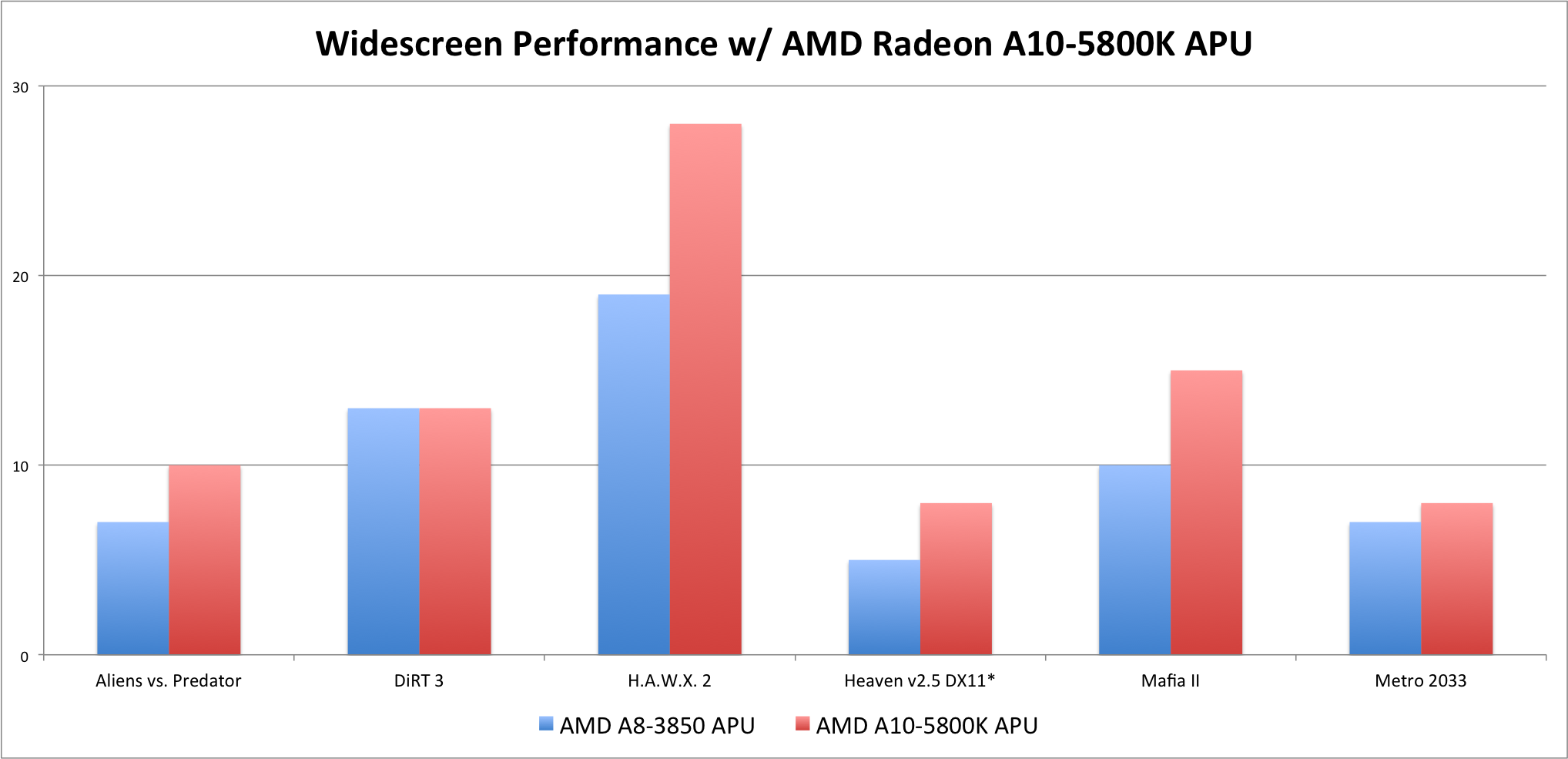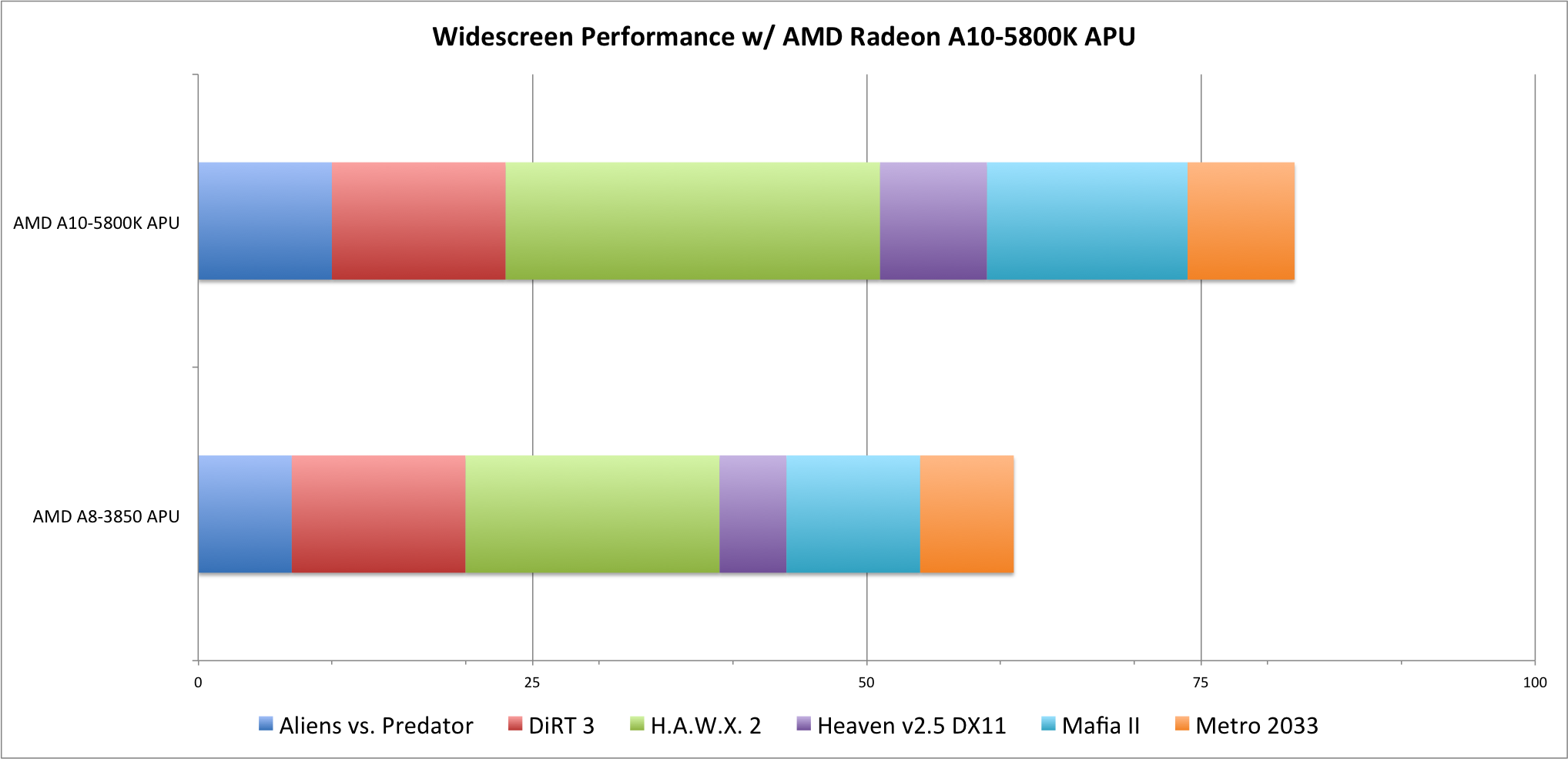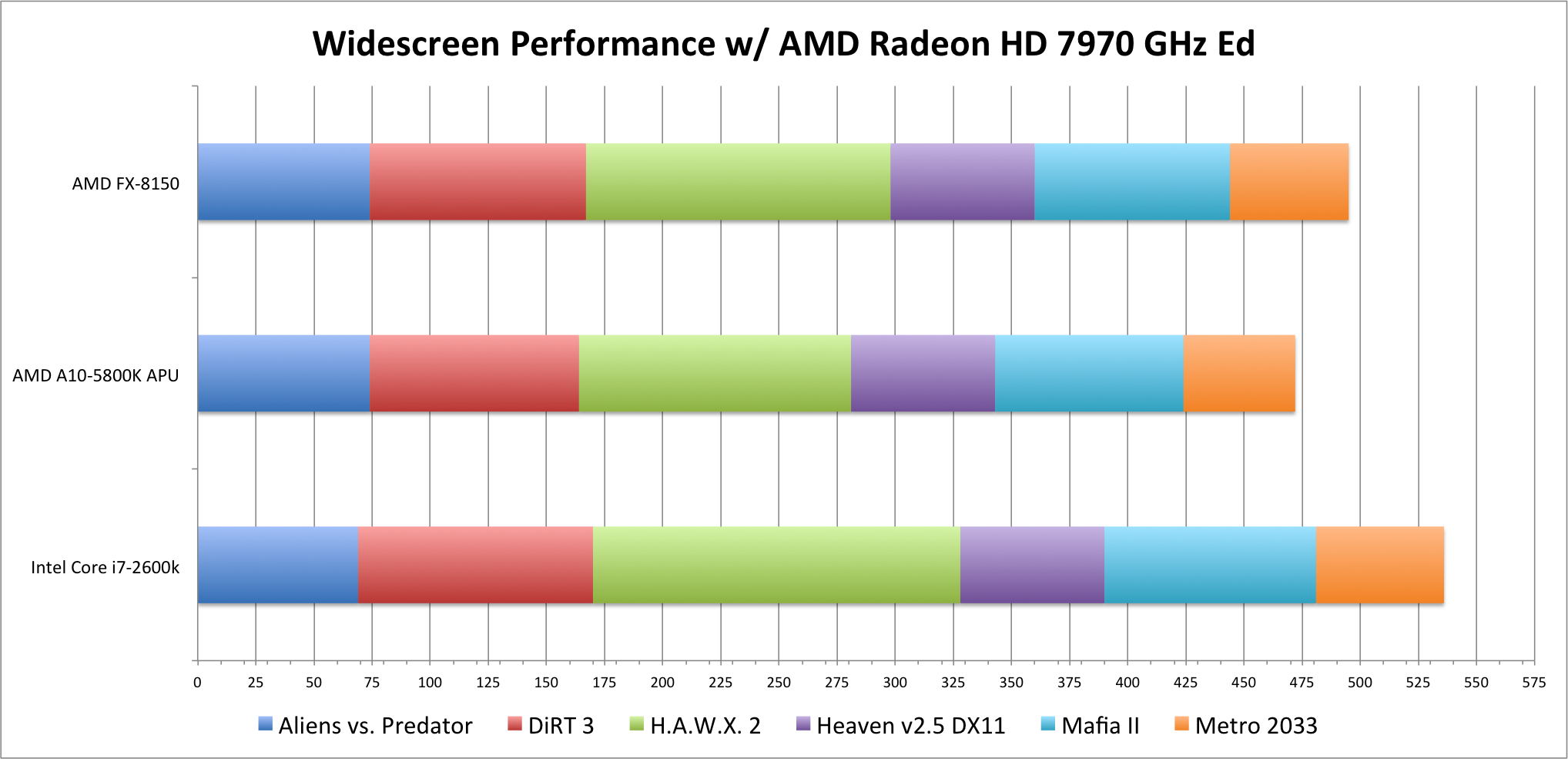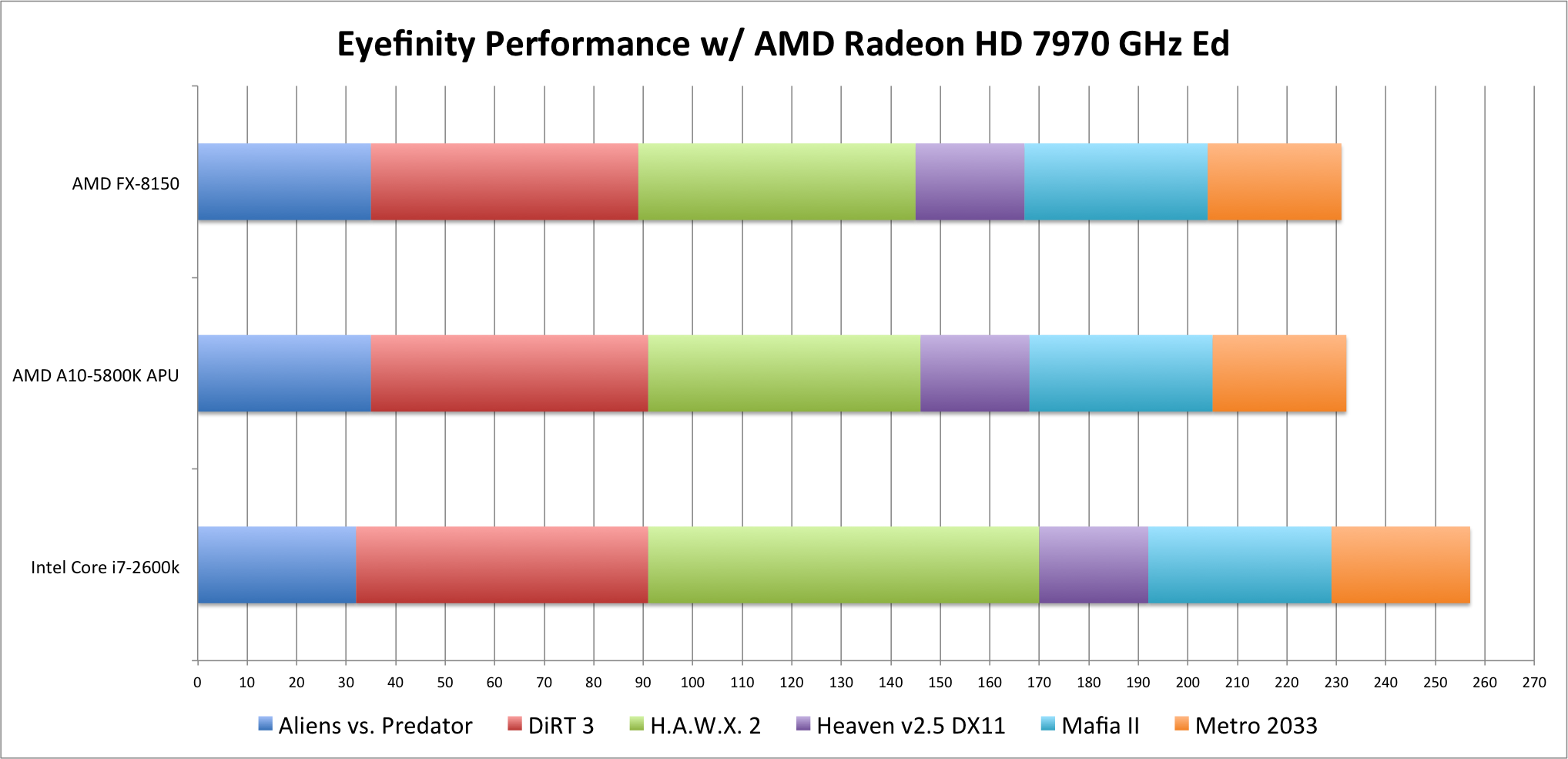AMD Trinity A10-5800K Review - Testing & Conclusions
Note on Testing
After posting this, one of the Insiders here at the WSGF started asking questions about the A10 and my testing. It came to light that I only used DDR3-1600 RAM in my testing (the RAM which I pulled from my FX-8150). Turns out that with the APU, the speed of RAM can have a noticeable impact on the performance. Using the proper DDR3-1866 RAM, the numbers here should increase by about 10%. So, as impressive as the performance is outlined, it is actually that much better. Sorry about the mistake. I'm certain the floggings are imminent...
APU Gaming Performance
In a pleasant surprise, AMD allowed media outlets an opportunity to offer preview analysis of the A10-5800K. Specifically we were allowed to publish gaming benchmarks of the new flagship APU. While the A10 is targeted at the Intel i3, I don't have one of those to test against. So, I put the A10 through our current test suite and compared it against the A8-3850 from last year.


The A10 flagship APU is 33% faster than the previous king of the lineup, the A8-3850. However, in our stress testing (which is designed to humble discrete GPUs), the A10 didn't produce truly playable framerates in any instance we tested. Please note, the testing we normally perform isn't geared towards this type of product. So, I set about making adjustments to the quality settings in our test suite and found that in several of the titles hit a playable 30fps with only slight adjustments.
Dirt 3 and HAWX 2 were able to hit a solid 30fps (with Dirt 3 able to maintain a verifiable minimum above 30fps) with only minor adjustments to the quality settings. Still maintaining "High" settings, the A10 APU was able to provide a solidly playable experience.
Additionally, I did a second round of testing on additional popular/mainstream/indie titles. As an update to my testing of the A8, I looked at Deathspank, Guild Wars, Orcs Must Die! and Torchlight. In the spirit of testing sequels I also looked at Guild Wars 2, Orcs Must Die! 2, and Torchlight II. I also looked at Jet Set Radio HD (remake of one of my favorite Dreamcast titles).
I found that the A10 offered consistent performance improvements over the A8 (tested at 1080p). However, in most instances the A8 was already playable in the original titles I tested. Testing the A10 in the series of sequels confirmed that the AMD A10 APU has enough power to consistently delivered 30fps+ in currently popular titles.
CPU Performance
If you look around the Interwebs at CPU reviews, you will find a lot of different programs used to test CPU power: Cinebench, SiSoft Sandra, Handbrake, WinZip, 7-Zip and various takes on H.264 video encoding. These tests do a great job at testing the raw power of the silicon, I have my doubts on how they translate into real-world usage and actual return on your investment. How well do those results translate into common daily tasks, and more importantly - gaming?
How many of us are using tools like Cinema 4D (the basis for Cinebench) or Maya to make movies or games? Handbrake is something that a lot of people might use on a routine basis. But I haven't ripped a DVD in a long time. With the advent of Netflix, Amazon Prime Video and iTunes, I rarely buy physical media. Looking at WinZip, I rarely use it. I use Windows "Send to Compressed Folder" for the few instances I share a handful of screenshots across Dropbox.
Most of the CPU tests used are highly optimized apps that take real advantage of the multi-threading capabilities found in multi-core processors. Conversely, most of the apps we use on a daily basis, and most of the games we play aren't that well optimized. I think CPU testing should reflect a real, honest use-case of your daily computing. My guess is that like me, most of you use your PCs for email, web surfing, using Google docs (or some equivalent), and gaming.
Ultimately we are a gaming site, so we will focus on games for our CPU tests. In my opinion a CPU should be tested with regards to how it marries with a GPU. Remove the GPU bottleneck by using the best GPU you can find, and see how games perform.
To this end, I took our test suite and benchmarked each CPU with a Radeon HD 7970 GHz Edition installed. I ran each title at 1080p and 3x1080p Eyefinity.




In widescreen, the A10 clocks in 5% slower than it's bigger brother the FX-8150. The top-end Intel i7-2600k is almost 14% faster than the A10 APU. In Eyefinity, the differences are less. The two AMD chips offer nearly identical performance, and the Intel chip is only 10% faster.
Digging into the data a little bit, we find that almost all of the Intel advantage comes from its improved performance in H.A.W.X. 2. The boost in performance for H.A.W.X. 2 is ironic, as it's really not needed. In our testing the A10 almost hit 120fps in single screen, and almost hit 60fps in Eyefinity. The push above 60fps in Eyefinity is certainly a nice benchmark, but push from 117fps to 158fps at 1080p is certainly superfluous.
If we remove the H.A.W.X. 2 data from the analysis (considering it is not indicative of how other titles perform), we find that the Intel i7-2600k is only 6.5% faster in single screen, and less than 1% faster in Eyefinity.
Conclusions & Final Thoughts
| Price | Widescreen | Eyefinity | ||||
| Frames | Frames/$$$ | Frames | Frames/$$$ | |||
| AMD A10-5800K | $129 | 472 | 3.66 | 232 | 1.80 | |
| AMD FX-8150 | $189 | 495 | 2.62 | 231 | 1.22 | |
| Intel i7-2600k | $299 | 536 | 1.79 | 257 | 0.86 | |
The AMD A10-5800K APU is a damn fine product. It offers a great combination of features at a very attractive price. Out of the box you can use Eyefinity for productivity tasks, and you get decent gaming performance on a single screen.
As long as you have reasonable expectations (30fps), and don't expect to have all the eye candy, the integrated GPU in the A10 will give you a good 1080p experience - all without the need for a discrete GPU. For someone on a budget, the A10 provides a great place to start when building a gaming rig.
When we do add a discrete GPU, we find that the A10 holds its own quite well. It's not the fastest chip on the market, but it doesn't lag that far behind flagship CPUs from either AMD or Intel. The real kicker is that it provides this performance at 2/3 the price of the AMD FX-8150 and less than half the cost of the Intel i7-2600k.
So, what can you do with the money saved? For the $60 saved versus the AMD FX-8150 you could pick up a 64GB SSD or some extra RAM (8GB costs less than $40). Or, you could invest in a good gaming mouse, or get a better keyboard.
For the $170 you'd save over the Intel i7-2600k you could get a 128GB SSD, or a gaming mouse/keyboard combo such as the Corsair K90/M90 set. With that much money you could also invest in a much better GPU, or work towards your Eyefinity/Surround setup by picking up another monitor.
The AMD A10 APU launches at a great price, and delivered stellar real-world gaming performance. This combination results in an amazing price/performance ratio, and the A10-5800K can serve as the foundation of great, balanced system build. For this, the A10-5800K is highly recommended from the WSGF.

